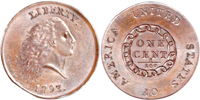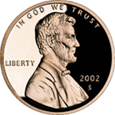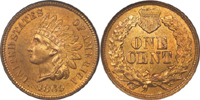 The internet provides many tools to make your money work hard for you but have you ever thought about how to make that jar of pennies on the dresser worth more?
The internet provides many tools to make your money work hard for you but have you ever thought about how to make that jar of pennies on the dresser worth more?
A penny for your thoughts; maybe even more...
Have you ever wondered why the US continues to mint the penny? These days a penny won't get you much - really it won't get you anything at all by itself in monetary form, or face value; however, if you're patient and know what to look for, a penny could be worth more than you may think! I thought with the anniversary of Lincoln's birthday and the anniversary of the Lincoln cent, as well as, the unveiling of the new designs that this was the perfect time to delve further into the coin.
In our house we never spend our pennies - it's against the law! The numismatic bug bit us and it's actually a lot of fun.
The penny made its appearance long ago in different forms known by different names; silver in content and called novus denarius or drachma or cent or pence...the list goes on. The penny, originally pressed in silver and then reduced in weight over time, was finally pressed in the US around 1787 and first pressed in copper here. It is widely believed that Ben Franklin actually designed the first US penny. The image on the first cent was of a lady facing left with flowing hair symbolizing liberty. The look of the penny has changed over the years and if you have a penny of original design you may be pretty well set for retirement!
The penny's many designs include the Indian cent which was 100% copper and the Wheat-back Lincoln cent minted long after the Civil War where the copper content was decreased to 95% and the added metal was 5% zinc. Throughout WWII pennies were made of steel with a zinc cover because the copper was necessary for military purposes. Today it costs about 1.23¢ to mint a penny.
Today's penny is morphing yet again and the Lincoln cent is getting a face lift! In recognition of the bicentennial of President Abraham Lincoln's birth and the 100th anniversary of the first issuance of the Lincoln cent, this year the US Mint is minting and issuing four different pennies with various themes including Lincoln's birth and early childhood in Kentucky to his formative years in Indiana followed by his professional life in Illinois ending with his presidency in Washington, DC.
Many believe the penny should be done away with however economists warn that this will lead to rounding up to the nickel causing an increase in cost to consumers at every turn from the filling the gas tank to buying groceries. Pennies are important to our every day lives and to our nation's economy.
Why not get a mint set for your kids? Check your change jars and see what you may have. You never know what you'll find!
Interesting Internet sites to find numismatic information:
 The United States Mint - The United States Mint was created by Congress on April 2, 1792. It receives more than $1 billion in annual revenues. The US Mint is a self-funded agency and turns over revenues beyond its operating expenses over to the General Fund of the Treasury. The primary mission is to produce an adequate volume of circulating coinage for the nation to conduct its trade and commerce.
The United States Mint - The United States Mint was created by Congress on April 2, 1792. It receives more than $1 billion in annual revenues. The US Mint is a self-funded agency and turns over revenues beyond its operating expenses over to the General Fund of the Treasury. The primary mission is to produce an adequate volume of circulating coinage for the nation to conduct its trade and commerce.
Coinflation- This site put together by Alec Nevalainen is dedicated to daily updates pertaining to measuring intrinsic metal value of coins around the world. He coined, pun intended, the term coinflation and went on to define it as: Coinflation [koin-fley-shuhn] noun. 1. A persistent rise in the metal value of silver and base metal coins. 2. An inflationary effect on coins. 3. The difference between the metal value and face value in coins.
Pennies.org - This site is dedicated to inform and educate policymakers, consumers, and the media about the penny's economic, cultural, and historical significance. This group, Americans for Common Cents (ACC) propagates penny fundraising initiatives that prove when pennies come together they sometimes add up to thousands of dollars.
 American Numismatic Society - Organized in 1858 and incorporated in 1865 the American Numismatic Society's original objective was "the collection and preservation of coins and medals, the investigation of matters connected therewith, and the popularization of the sciences of Numismatics," have evolved into the ANS' current mission. The current mission statement may be found on the site along with other great educational information on the subject.
American Numismatic Society - Organized in 1858 and incorporated in 1865 the American Numismatic Society's original objective was "the collection and preservation of coins and medals, the investigation of matters connected therewith, and the popularization of the sciences of Numismatics," have evolved into the ANS' current mission. The current mission statement may be found on the site along with other great educational information on the subject.
I hope as you check out at the register and pay with paper money - a rarity these days - that you'll take a closer look at the pennies you get for change. Who knows - you may find a penny that will change your life or have fun looking!
What are your thoughts about pennies? We always enjoy feedback! Contact me at trish.cunningham@brookwoods.com.